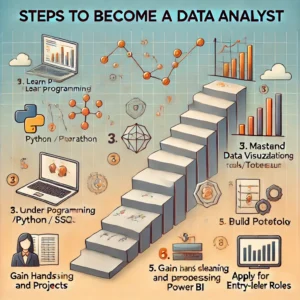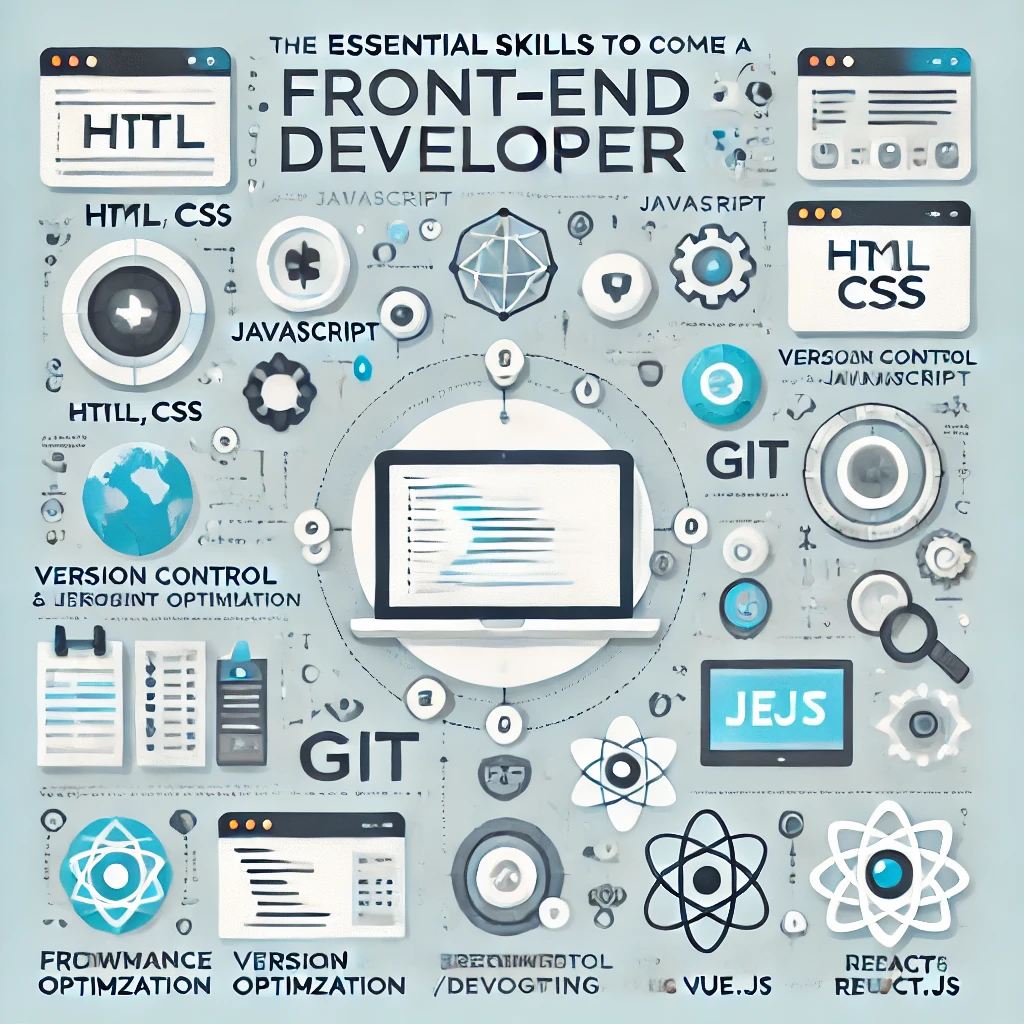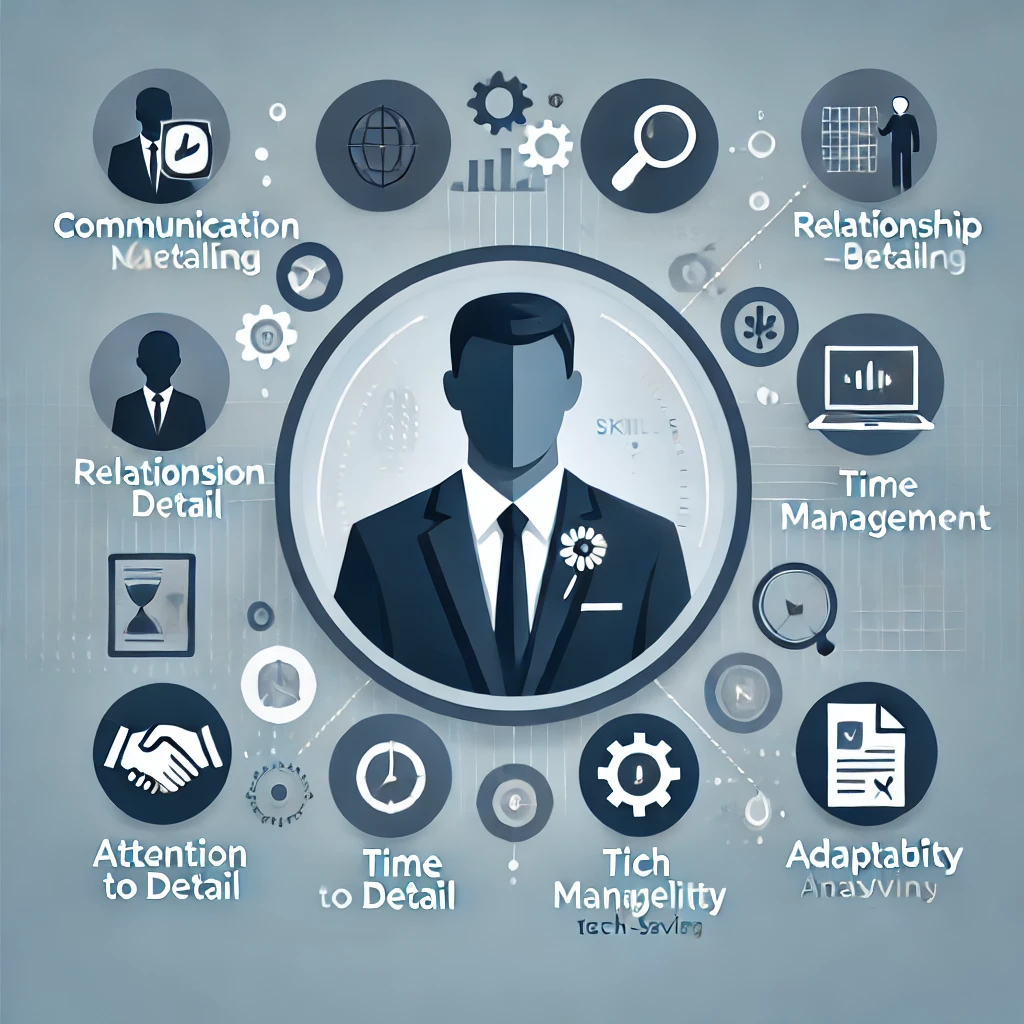How to Become a Data Analyst- A data analyst is a professional who gathers, processes and interprets data to help businesses make better decisions. Becoming a data analyst involves acquiring a blend of technical and soft skills, gaining relevant experience, and leveraging educational qualifications to solve real-world problems through data.
Steps to Become a Data Analyst

Responsibilities of a Data Analyst.
A data analyst is a professional who works with data to help organizations make better decisions. Their job involves several important steps, which can be broken down as follows:
1. Collecting Data:
Data analysts gather data from different sources. These sources might include databases, online surveys, sales records, or customer feedback forms. For example, a data analyst in retail might collect information about daily sales and customer preferences.
2. Cleaning Data:
Raw data is often messy. It might have missing values, duplicate entries, or errors. Data analysts clean the data to ensure accuracy and consistency. This process is called “data cleaning” and is a crucial step before any analysis can begin.
3. Analyzing Data:
Once the data is clean, the analyst starts making sense of it. They use statistical methods and tools to identify patterns, trends, or problems. For instance, a data analyst at an e-commerce company might study shopping trends to predict which products will sell more during the holiday season.
4. Interpreting Data:
Data analysts turn numbers into insights. They look for answers to specific questions, such as:
- Why are sales dropping in a particular region?
- What type of customers are most likely to buy a new product?
- Which marketing campaign is performing best?
5. Creating Visualizations:
To make the findings easier to understand, data analysts create visual representations of the data. They use tools like charts, graphs, and dashboards. For example, instead of showing a spreadsheet of numbers, they might create a bar graph showing which products are the best sellers.
6. Communicating Insights:
Finally, data analysts share their findings with decision-makers. They prepare reports or presentations to explain what the data means and suggest what actions the organization should take. A good data analyst ensures that their insights are clear, actionable, and easy for non-technical stakeholders to understand.
Examples of a Data Analyst’s Work.
- In healthcare, a data analyst might analyze patient records to identify trends in diseases and recommend better treatment plans.
- In marketing, they could study customer behavior to improve advertising campaigns and target the right audience.
- In sports, they may track player performance data to help coaches develop winning strategies.
Importance of Data Analysts.
Data analysts help organizations:
- Make informed decisions.
- Save money by identifying inefficiencies.
- Improve customer satisfaction by understanding preferences.
RELATED BLOG: Challenges and Future of Data Scientist
Steps to Become a Data Analyst.
1. Understand the Role of a Data Analyst.
Before going in to the role, take time to understand what a data analyst does. Research their day-to-day responsibilities, tools, and how their work benefits organizations. Knowing this will help you determine if this is the right career path for you. Start by reading job descriptions for data analyst roles. Look at what companies are asking for in terms of skills, tools, and education. Watch videos or read interviews with working data analysts to gain a realistic perspective on the job.
2. Get the Right Education.
While formal education isn’t always necessary, having a strong foundation helps.
- Bachelor’s Degree: Pursue a degree in fields like mathematics, statistics, computer science, business analytics, or economics. These programs often cover the basics of data analysis and programming.
- Alternative Learning Paths: If a degree isn’t an option, online courses, boot camps, and certifications can give you the knowledge and skills you need.
Key subjects to focus on:
- Basic statistics and probability.
- Data structures and algorithms.
- Business communication.
3. Learn the Must-Have Skills.
Developing essential skills is crucial to becoming a successful data analyst.
- Excel Skills: Start with Excel, one of the most widely used tools for data analysis. Learn to organize data, use formulas, and create pivot tables.
- SQL for Databases: Learn SQL to retrieve, manipulate, and manage data from databases. Begin with basic queries like SELECT, JOIN, and GROUP BY;
- Programming: Python or R is essential for analyzing and visualizing large datasets. Start with beginner-friendly libraries like Pandas, NumPy, and Matplotlib.
- Data Visualization: Learn to present your findings visually. Use tools like Tableau, Power BI, or Python libraries to create charts and dashboards.
- Statistics and Problem Solving: Study statistical methods such as regression analysis, probability, and hypothesis testing.
These skills help you draw accurate conclusions from data.
4. Practice with Real-World Data.
Practical experience is invaluable. Start by working on small projects that use publicly available datasets.
- Websites like Kaggle, Data.gov, and Google Dataset Search offer free datasets.
- Analyze real-world problems like sales trends, customer behavior, or social media engagement.
- Create visualizations and summaries to showcase your results.
This practice helps you understand the end-to-end process of data analysis. Save your projects in a portfolio to demonstrate your skills to potential employers.
5. Earn Certifications.
Certifications add credibility to your resume and signal your commitment to learning. Popular certifications include:
- Google Data Analytics Professional Certificate: Covers the basics of data cleaning, analysis, and visualization.
- Microsoft Certified: Data Analyst Associate: Focuses on Power BI and other Microsoft tools.
- Tableau Desktop Specialist: Teaches you how to create dashboards and reports.
- IBM Data Analyst Professional Certificate: A beginner-friendly course on tools like Excel, Python, and SQL.
Choose certifications that align with the tools and industries you’re interested in.
6. Build a Portfolio.
A strong portfolio showcases your skills and sets you apart. Here’s what to include:
- Projects that involve cleaning and analyzing datasets.
- Visualizations like dashboards and charts.
- Written summaries explaining the steps you took and the insights you gained.
Publish your portfolio on platforms like GitHub, Tableau Public, or LinkedIn. Sharing your work online increases your visibility and helps recruiters find you.
7. Gain Practical Experience.
Landing a job often requires experience. Here’s how to start:
- Internships: Apply for internships in data analysis to gain hands-on experience.
- Freelancing: Offer your skills to small businesses or nonprofits. This could include analyzing customer surveys or sales data.
- Volunteering: Use your skills to support a cause. Many organizations need help with data, even if they don’t have a budget.
Each project you complete adds valuable experience to your resume.
8. Network with Professionals.
Networking can open doors to job opportunities and mentorship.
- Join online communities like LinkedIn groups, Reddit forums, or Slack channels focused on data analysis.
- Attend webinars, workshops, or local meetups to connect with others in the field.
- Follow industry experts on social media to stay updated on trends and opportunities.
Let your network know you’re actively seeking data analyst roles, they might recommend you for openings.
9. Start Applying for Jobs.
Once you’ve gained the necessary skills and experience, start applying for entry-level data analyst positions.
- Tailor your resume to highlight your relevant skills, tools, and projects.
- Prepare for interviews by practicing common questions like:
“Can you explain how you cleaned a dataset?”
“What tools have you used for data visualization?”
- Showcase your portfolio to demonstrate your capabilities.
Focus on companies that align with your interests, whether it’s tech, finance, retail, or healthcare.
10. Continue Learning and Growing.
The field of data analysis grows rapidly. Stay competitive by continuing to learn.
- Take advanced courses on machine learning, data engineering, or business intelligence.
- Explore new tools and technologies to broaden your skill set.
- Keep practicing with new datasets to refine your techniques.
Lifelong learning ensures that you’ll stay relevant and ready for new challenges.
RELATED BLOG: 10 Common Skills Required to Become a Virtual Assistant
Essential Skills for a Data Analyst.
To become a successful data analyst, you need to master several critical skills. These skills not only help you perform your tasks efficiently but also make you stand out in the job market. Let’s break them down:
1. Technical Expertise:
You must be comfortable using tools and software designed for working with data. Here are the essentials:
- Excel: A must-have tool for organizing data, creating pivot tables, and performing basic analysis.
- SQL: This is the backbone of data analysis. It allows you to extract and manipulate data from databases.
- Programming Languages: Learn Python or R to automate repetitive tasks, clean data, and perform advanced analytics.
- Data Visualization Tools: Tableau, Power BI, or Matplotlib help you create charts, dashboards, and reports that are easy to understand.
Start small, mastering one tool at a time, and gradually expand your expertise.
2. Analytical Thinking.
This is the ability to break down problems into smaller parts and solve them step by step. You should:
- Look at the data critically.
- Ask questions like, “What is this data telling me?” or “What trends are emerging?”
- Think of solutions or recommendations based on the findings.
Strong analytical thinking helps you identify patterns that others might miss.
3. Statistical Knowledge.
Statistics form the foundation of data analysis. You need to understand basic concepts such as:
- Mean, median, and mode.
- Variance and standard deviation (how data spreads out).
- Correlation and regression (how variables are related).
These concepts help you interpret data accurately and make predictions.
4. Data Cleaning Skills.
Raw data is often messy. It can have missing values, duplicates, or errors. Cleaning data ensures it’s reliable and ready for analysis.
- Use Excel or Python to clean datasets.
- Check for missing or inconsistent data entries.
- Remove duplicate records.
This step is crucial because analysis on bad data leads to bad decisions.
5. Problem-Solving.
Every dataset represents a question or challenge. Your job is to find the answers by:
- Defining the problem clearly.
- Exploring the data to identify possible solutions.
- Testing those solutions to see what works best.
Problem-solving is like detective work, you dig deep to uncover insights.
6. Communication Skills.
It’s not enough to analyze data; you must explain your findings to others. Here’s how:
- Simplify Complex Ideas: Avoid technical jargon when speaking to non-technical audiences.
- Use Visuals: A well-designed chart or graph makes data easier to understand.
- Write Clearly: Summarize your findings in concise and actionable reports.
Good communication ensures stakeholders understand and trust your insights.
7. Attention to Detail.
Accuracy is critical in data analysis. Small mistakes can lead to wrong conclusions. Pay close attention when:
- Inputting or cleaning data.
- Running calculations or scripts.
- Creating reports or visualizations.
Double-check your work at every step to ensure it’s error-free.
8. Curiosity and Adaptability.
The world of data is constantly changing, with new tools and techniques emerging all the time. To stay ahead:
- Be curious about trends in the field.
- Take online courses or attend workshops.
- Experiment with new tools and methodologies.
A mindset of continuous learning ensures you remain competitive in your career.
9. Business Acumen.
Understanding the industry you work in helps you ask better questions and provide more relevant insights. For example:
- A retail data analyst needs to understand customer behavior and sales trends.
- A healthcare data analyst should know about patient care processes and hospital operations.
Aligning your analysis with business goals adds more value to your work.
RELATED BLOG: Top 10 Qualities Of A Brand Manager
Common Tools Used by Data Analysts.
To excel as a data analyst, mastering the right tools is essential. These tools help in tasks like analyzing data, managing databases, and creating visualizations. Here’s a detailed explanation of the most commonly used tools and their functions:
1. Data Analysis Tools.
These tools are used to process and analyze data effectively:
- Excel: A versatile tool for organizing, cleaning, and performing basic to advanced data analysis using formulas, pivot tables, and macros.
- Python: A programming language widely used for data analysis, offering powerful libraries like Pandas (for data manipulation) and NumPy (for numerical computations).
- R: A statistical programming language that excels at data visualization and statistical analysis, making it popular for academic and research purposes.
2. Database Tools.
Databases store large amounts of structured data. Analysts need tools to retrieve and manipulate this data:
- SQL (Structured Query Language): The most common language for querying databases. It allows analysts to filter, join, and manipulate data from relational databases like MySQL and PostgreSQL.
- NoSQL Databases: Tools like MongoDB store unstructured or semi-structured data, making them suitable for handling large-scale datasets like social media data or JSON files.
3. Data Visualization Tools.
These tools transform raw data into visually appealing and easy-to-understand charts or dashboards:
- Tableau: A drag-and-drop interface that allows users to create interactive dashboards and visualizations without needing advanced coding skills.
- Power BI: Microsoft’s visualization tool, perfect for creating dynamic reports and integrating with other Microsoft products like Excel and Azure.
- Matplotlib and Seaborn: Python libraries used to create high-quality static, animated, or interactive visualizations.
4. Big Data Tools:
For analyzing massive datasets that go beyond traditional tools:
- Hadoop: A framework that processes large datasets across distributed systems. It’s commonly used for managing unstructured data.
- Spark: A big data tool that processes data much faster than Hadoop, thanks to its in-memory processing capability.
5. Other Useful Tools:
- Google Analytics: Ideal for web data analysis, tracking user behavior, and website performance.
- Jupyter Notebooks: An open-source tool where analysts can write and document code in an interactive environment, especially for Python and R projects.
- GitHub: A platform to store, share, and collaborate on code and projects, which is helpful for showcasing your data analysis work.
Career Path of a Data Analyst.
The journey doesn’t stop at becoming a data analyst. Here’s how the career progresses:
- Junior Data Analyst: They focus on basic data cleaning and analysis tasks.
- Data Analyst: They handle advanced projects, work with large datasets and lead reporting.
- Senior Data Analyst: They manage teams, mentor juniors, and work on strategic initiatives.
- Specialized Roles: Transition into areas like data engineering, data science, or business intelligence.
Challenges in the Field.
Being a data analyst can be rewarding but comes with challenges:
- Handling unstructured data.
- Balancing multiple stakeholder demands.
- Keeping up with rapidly changing technologies.
Conclusion
Becoming a data analyst is an interesting journey filled with opportunities to solve real-world problems and make a good impact. By learning essential skills, gaining experience, and staying curious, you can make out a great career path in this growing field.












